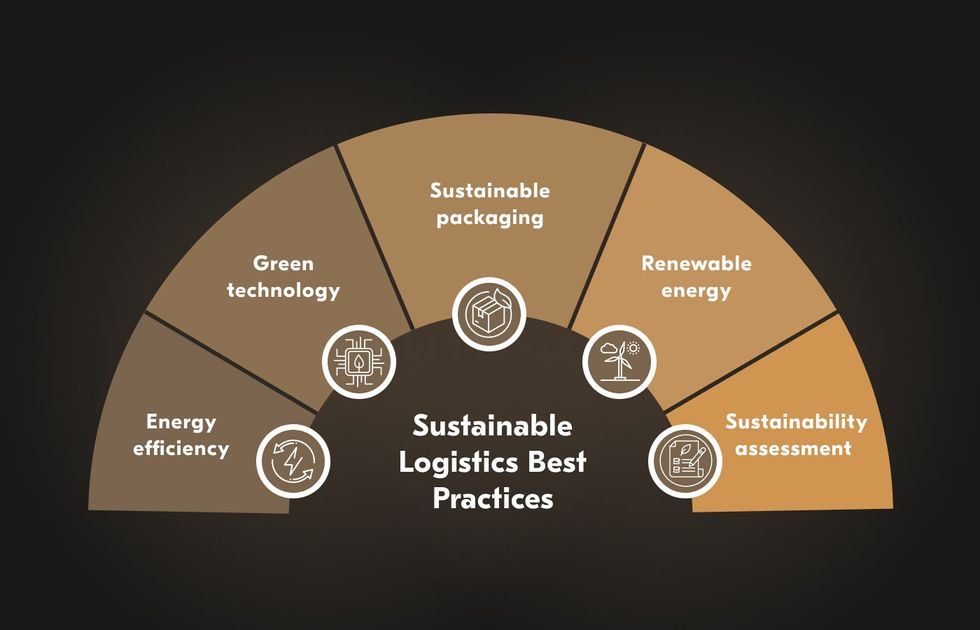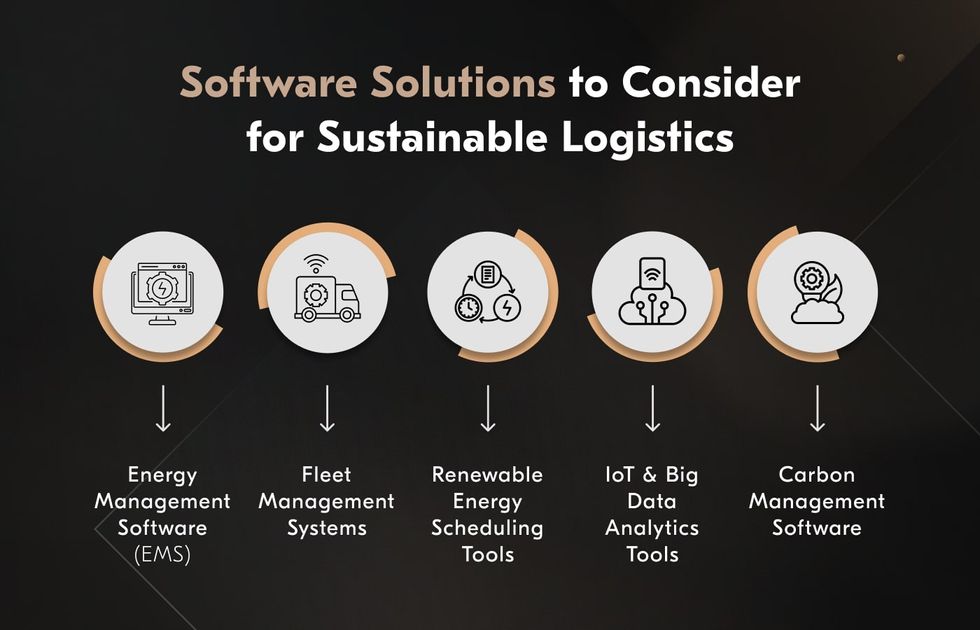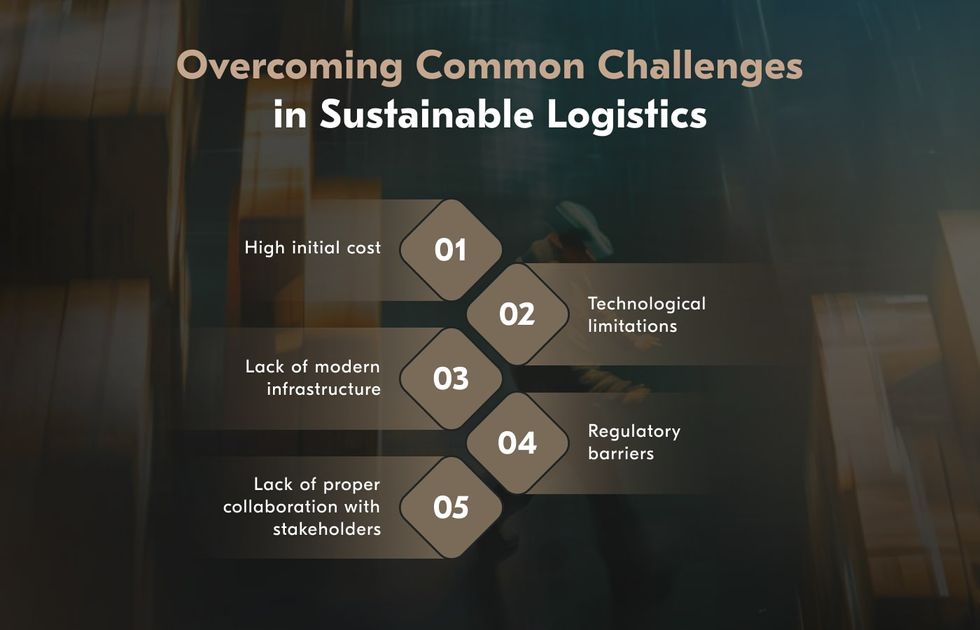
Key Takeaways
- Sustainable logistics benefits the environment by reducing carbon emissions, conserving resources, and improving air quality.
- Operationally, it boosts efficiency, cuts costs, and strengthens corporate reputation.
- Consumers increasingly favor brands with eco-conscious values, with 66% of respondents indicating they consider sustainability when making purchasing decisions.
- Sustainable transportation practices contribute to long-term savings through reduced fuel usage, energy efficiency, and improved logistics performance.
- The green logistics market is set out to grow from $1.39 trillion in 2025 to $2.06 trillion by 2030, driven by rising environmental regulations.
In recent years, logistics and supply chains have showcased remarkable resilience, adapting to challenges while embracing sustainable practices. Sustainable transportation, in particular, has emerged as a critical focus, setting the tone for strategic, operational, and commercial changes in the industry.
This shift is driven by growing stakeholder demands for higher sustainability standards across the entire supply chain, from manufacturers to retailers and service providers. The urgency is clear: by 2050, logistics could be responsible for 40% of global carbon dioxide emissions without proper measures. But beyond reducing emissions and mitigating environmental risks, adopting green logistics strategies also makes strong business sense. At Acropolium, we focus on key challenges and objectives when crafting logistics software and keep track of the latest industry trends. Today, we want to dive deeper into the world of sustainable logistics, its benefits, and use cases to show you why adopting green practices is essential in 2025.
What is Sustainable Transportation in Logistics?

Sustainable logistics, often called green logistics, encompasses strategies that aim to minimize the environmental impact from supply chain operations. This logistics trend includes everything from sourcing raw materials to transporting finished products to customers, all while prioritizing eco-friendly methods and minimizing waste.
The green logistics market is projected to grow from $1.39 trillion in 2025 to $2.06 trillion by 2030, with a CAGR of 8.29%. Such growth is driven by rising environmental regulations, corporate social responsibility initiatives, EV adoption in transportation, and the integration of AI into supply chains.
The Role of Sustainability in Logistics
A sustainability strategy fosters innovation and agility while helping your business identify inefficiencies in logistics operations with renewable energy practices. By making changes that benefit both the environment — such as adopting sustainable transportation solutions — you can achieve the following:
- Combat climate change. The logistics sector is a major source of carbon emissions. Sustainable practices in logistics management, like electric vehicles and delivery route optimization, can significantly reduce your carbon footprint.
- Improve air quality. Cleaner transport modes and energy-efficient practices reduce pollutants, leading to better air quality and improved community health, especially near logistics hubs.
- Conserve resources. Efficient use of fuel, energy, and materials through initiatives like recyclable packaging and optimized warehouse operations preserves natural resources for future generations.
- Boost operational efficiency. Streamlining delivery routes through GPS tracking systems and utilizing energy-efficient warehouses can lower costs and enhance logistics performance, delivering economic and environmental benefits.
- Strengthen corporate reputation. Adopting renewable energy in logistics builds trust, attracts eco-conscious investors, and provides a competitive edge, with transparency and sustainability reporting reinforcing your commitment.
Consumers, in turn, increasingly prioritize sustainability in their purchasing decisions. A McKinsey survey revealed that 66% of respondents actively consider sustainability, favoring brands that align with their values.
This trend underscores a new era in logistics, where environmental responsibility goes hand-in-hand with meeting customer expectations and ensuring long-term business success.
Benefits of Sustainable Transportation & Green Energy Solutions

The logistics field faces a significant challenge due to its heavy reliance on transportation and machinery to prepare goods and move them across often vast distances. However, businesses that commit to addressing this challenge and step toward sustainability in logistics can gain substantial advantages.
Environmental Benefits
Sustainable logistics cut greenhouse gas emissions and pollution by using smarter practices like route optimization and electric vehicles. With tools like cloud-based transportation systems, businesses can analyze data, reduce fuel use, and make their routine more efficient.
These efforts also conserve natural resources by adopting recyclable packaging and investing in better energy storage, like battery technology.
Economic Advantages
Sustainable transportation practices save money in the long run by improving energy use and reducing fuel expenses. Machine learning helps identify inefficiencies and adjust routes quickly, while electric and hybrid vehicles keep costs low without sacrificing performance.
Going green doesn’t just save money but boosts your reputation. Customers and stakeholders notice when companies take sustainability seriously, which can lead to stronger loyalty and more business opportunities.
Regulatory Compliance
Governments are asking for more transparency in logistics, especially when it comes to emissions data. Companies using digital systems for tracking their carbon footprint stay ahead of these demands.
Reducing emissions and switching to greener technologies is one of sustainable transportation examples where it helps improve relationships with customers, governments, and other stakeholders.
In other words, staying proactive with sustainability keeps your business in a strong, competitive position.
Best Practices for Integrating Renewable Energy in Logistics

As sustainable transport solutions become the industry standard, over 40% of logistics operators win business due to their eco-friendly operations. At the same time, 92% of logistics businesses and 79% of manufacturers operate with sustainability policies.
Global giants like Amazon, UPS, and DHL are spearheading initiatives to integrate renewable sources into their supply chains. Let’s take a closer look at sustainable transportation examples and practices adopted today:
- Electric-powered vehicles and equipment are becoming essential for urban deliveries and warehouse efficiency.
- Logistics facilities are increasingly powered by renewable energy sources such as solar and wind.
- Hydrogen fuel cells show great potential for decarbonizing long-haul transport.
- Advancements in electric rail and hybrid maritime solutions are transforming freight movement.
Energy Efficiency
By leveraging advanced sustainable transportation practices and routing technologies, companies can minimize travel distances, avoid congestion, and optimize delivery schedules to reduce fuel usage. Additionally, ensuring that containers and transport vehicles are packed to maximum capacity helps eliminate wasted energy and lowers emissions per unit transported.
Adoption of Green Technologies
Electric-powered vehicles are becoming the norm for last-mile deliveries, while logistics facilities are increasingly utilizing renewable energy sources like solar panels and wind turbines. The former provides a scalable solution for logistics hubs, especially in windy regions, becoming a reliable renewable energy source.
Thus, Maersk has adopted sustainable logistics by investing in wind-assisted propulsion systems for its cargo ships. Simultaneously, Amazon deploys electric delivery vans and solar installations as part of their sustainable transportation, while UPS invests heavily in hydrogen-powered trucks for long-haul operations.
Hydrogen fuel cells are particularly promising, offering zero emissions and extended ranges suitable for heavy-duty logistics.
Sustainable Packaging
Logistics companies are transitioning to recyclable, compostable, or minimal packaging to align with consumer expectations and reduce waste.
IKEA’s flat-pack designs and commitment to using 100% renewable or recyclable materials in packaging have minimized transportation costs and environmental impact.
Renewable Energy in Warehouse and Hub Operations
Solar energy is being increasingly adopted to power logistics hubs and vehicles for its ability to offer energy self-sufficiency and cost reduction. For example, Amazon has installed solar panels on many of its fulfillment centers worldwide, generating clean energy to power its operations.
Its fulfillment center in Tracy, California, relies on solar energy to supply a substantial portion of its electricity, supporting the company’s commitment to achieving net-zero carbon emissions by 2040.
Sustainability Assessment
Regularly assessing logistics strategies is essential to identify opportunities for greater sustainability. Businesses can evaluate their carbon footprint, energy use, and waste output to pinpoint inefficiencies and implement sustainable transport solutions.
Some businesses invest in low-code logistics platforms for the rapid development of tools to track and analyze data, providing insights into areas needing improvement. Blockchain technology is also a good idea for further support of these efforts.
By enabling live monitoring and verification of sustainability metrics across the supply chain, it ensures transparent reporting to customers and partners. Such assessments ensure continuous improvement and alignment with environmental goals while supporting transparent communication with stakeholders about green initiatives.
Software Solutions for Integrating Renewable Energy in Logistics

It takes a robust set of technology to adopt renewable energy in logistics: integrated through logistics APIs, these tools are designed to monitor, manage, and optimize energy usage effectively. Here are key innovative solutions that you should consider on your way to getting greener — whether you want to develop your own app or turn to a third party.
Energy Management Software (EMS)
EMS provides logistics businesses with the ability to monitor, control, and optimize energy consumption in real time, ensuring that solar panels and wind turbines are used to their full potential.
Such systems predict demand patterns and align renewable energy supply according to your sustainability objectives. Moreover, its ability to identify inefficiencies helps logistics centers lower energy waste.
Key Features:
- Real-time energy monitoring.
- Seamless integration with renewable energy systems like solar panels or wind turbines.
- Advanced analytics to predict energy demand and supply.
- Energy efficiency recommendations to enhance operational performance.
Fleet Management Software
Managing fleets powered by renewable energy sources requires specialized software tailored to the unique functionality of electric vehicles (EVs) and hydrogen-powered trucks. Fleet management software serves as a tool to plan routes, manage documentation, monitor energy consumption, and maintain the performance of eco-friendly vehicles.
With telematics systems, supply chain actors gain data-driven insights into vehicle health and energy consumption. This solution also helps plan charging schedules and locate EV charging stations, minimizing disruptions during long-haul deliveries and hence promoting sustainable logistics.
Key Features:
- Route optimization to reduce energy consumption.
- EV charging station locators and scheduling tools.
- Integration with telematics systems for vehicle performance monitoring.
- Predictive maintenance to ensure peak operational efficiency.
Renewable Energy Scheduling Software
The availability of renewable energy in logistics can fluctuate based on different environmental factors. Software for scheduling renewable energy analyses real-time data, with which you can make informed decisions and allocate energy resources dynamically across all your facilities.
It also uses weather data to account for variability in energy production, optimizing renewable energy utilization and reducing reliance on fossil fuels during low-output periods.
Key Features:
- Dynamic allocation of renewable energy resources based on demand.
- Integration with logistics workflows to align energy usage with operational timelines.
- Weather-based scheduling for improved energy availability planning.
IoT and Big Data Analytics Software
By uncovering the capabilities of connected devices, businesses can live-track assets for sustainability transportation like EV fleets and energy systems with precision. This approach relies on data collected from a network of sensors and converts it into deep insights into resource usage, asset performance, and operational patterns.
By leveraging predictive analytics, you can even anticipate energy needs, identify inefficiencies, and turn issues into proactive strategies.
Key Features:
- Continuous real-time monitoring of assets powered by renewable energy.
- Advanced analytics to refine energy usage and improve operational efficiency.
- Predictive models for accurate energy demand forecasting and trend analysis.
Carbon Management Software
With increasing pressure to meet regulatory standards and minimize carbon emissions, businesses turn to carbon management software to track greenhouse gas emissions. It gives a clear understanding of the environmental impact that your company has while supporting compliance with reporting tools.
Such sustainable logistics tools are meant to align with global sustainability standards. Furthermore, it may have simulation capabilities to evaluate how increased adoption of renewable energy sources affects overall emissions.
Key Features:
- Emissions tracking across supply chains.
- Reporting tools for compliance and sustainability goals.
- Simulations to assess renewable energy’s impact on emissions reduction.
Challenges of Sustainability in Logistics: Dealing with High Costs and Tech Limits

Transitioning to sustainable logistics often involves significant upfront expenses. Nearly two-thirds of companies, including 80% of logistics operators, struggle with the high costs of sustainable solutions. What’s more, over one-third view the lack of advanced technology as a major obstacle to improving sustainability.
Companies must invest in energy-efficient vehicles, renewable energy sources, and eco-friendly packaging. Additionally, technological limitations and the need for extensive infrastructure upgrades further compound these expenses. Here’s what you can do to make things work:
- Leverage government incentives and subsidies. Governments worldwide are offering financial incentives, tax credits, and subsidies to promote sustainable logistics. Try tapping into these resources to offset a portion of the initial investment.
- Invest in research and development. Focusing on R&D will help you design bespoke software solutions to your logistics operations. For example, you can cooperate with a web development agency to build hybrid fleet systems, experiment with renewable fuel alternatives, or create AI-driven software for supply chain efficiency. Long-term innovation reduces dependency on expensive, off-the-shelf technologies and ensures sustainable practices are cost-effective and scalable.
- Collaborate with stakeholders. Building partnerships with suppliers, local governments, and industry actors can facilitate the development of shared infrastructure, such as charging stations for electric fleets or sustainable packaging facilities. Collective efforts reduce the financial burden on individual companies while fostering industry-wide progress.
Why Choose Acropolium?
Acropolium dedicated teams leverage deep expertise to deliver bespoke, GDPR-compliant software solutions for the logistics industry. With ISO-certified processes and a proven track record in serverless solutions, we craft software that is scalable, secure, and reliable.
Understanding the challenges of modern logistics, we craft innovative tools that drive efficiency and meet regulatory standards. Here’s one of our success stories on sustainability transportation tools:
EV Charging App Development
An automotive company needed a CRM system to manage 1,000 EV charging points and a mobile charging app for users to locate and activate charging stations, handle payments, and track loyalty rewards.
Solution
Our developers delivered a scalable CRM platform with tools for station management, rate control, and customer loyalty programs alongside a user-friendly mobile app built with React Native. AWS cloud ensured secure and efficient data handling, while IoT integration enabled real-time processing.
Results
- Increased loyal user numbers by 50%.
- Boosted revenue from charging points by 45%.
- Improved transaction efficiency by 25%.
Final Thoughts
The shift towards sustainable transportation tools is driven not only by regulatory pressure but also by the recognition that green practices are essential for long-term efficiency and profitability.
While challenges such as high initial investment and technological limitations remain, the right approach to innovation can help mitigate these. As businesses align with sustainability goals, the logistics industry has to make a significant contribution to global environmental efforts.
And Acropolium will be there for you to help you go greener with your operational assets while staying competitive and meeting consumer expectations. Subscribe to our software development services or contact our team — we will transform your business with your budget in mind!









![Blockchain for Supply Chain Management: [Benefits & Use Cases]](/img/articles/why-and-how-to-employ-blockchain-in-supply-chain-management-tips-and-success-stories/img01.jpg)
![ᐉ Airport Operations Management Solftware [2025 Guide]](/img/articles/airport-operations-management/img01.jpg)
![ᐉ Logistics Customer Portal Development: [2025 Guide]](/img/articles/logistics-customer-portal-development/img01.jpg)
![ᐉ Warehouse Management Systems Development [2025 Guide]](/img/articles/warehouse-management-systems/img01.jpg)
